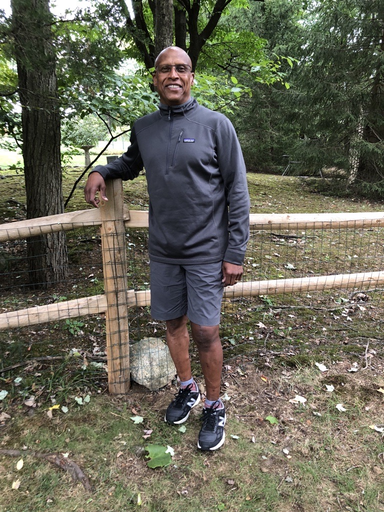
Michael knows how important your knees are in daily life. The joint that connects the bones of the upper and lower leg is needed for pretty much any form of movement including walking, driving, or lifting objects. For at least a decade, Michael suffered from arthritic knee pain that affected his function.
“I was in chronic pain for years and trying oral medications and knee injections,” he recalls. Unable to find relief, Michael turned to his long-time provider David Gold, MD, an orthopedic surgeon at Summit Health who specializes in robotic-assisted total knee replacements and has been managing Michael’s arthritis for nearly 15 years. “After my appointment, I decided it was finally time to commit to doing the surgery.”
Knee replacement surgery has evolved tremendously over the last decade. Arthritis is a disease that causes the cushion between the bones, known as cartilage, to wear away. In a knee replacement, the damaged cartilage and bone are removed and replaced with metal and plastic components. This allows the bones to move smoothly and more comfortably.
Robot-assisted technology has made this process more precise and been found to cause less damage to the bone and soft tissue. “Since I’ve been operating with robot assists this past year, I’ve been very impressed with how quickly my patients recover. They have less pain, more strength, and increased range of motion,” explains Dr. Gold, who notes the robot guides about 30 to 40% of the surgery.
“If you have bad knee arthritis and are starting to limit your daily activities, then you’re likely a good candidate for this surgery as long as you’ve tried more conservative methods such as medication or injections,” he adds.
Robotic-assisted knee replacements: what to expect
A week before surgery the patient has a CT scan of their leg, and a surgical plan is created. These images are also viewed on a screen in the operating room in real time.
“Many robotic-assisted knee replacements are starting to be same-day procedures, but I keep my patients overnight. I think it’s better for them to have medical supervision for the first 24 to 36 hours. During this time, they receive three rounds of physical therapy and are walking with help,” says Dr. Gold.
For the first two weeks, a nurse or physical therapist will provide treatment at home. Once the patient is more mobile, they can begin an outpatient physical therapy program. Dr. Gold says patients should expect to work hard with a physical therapist for about one to two months post-surgery.
The road to recovery
Everyone’s experience is different. But most patients return to work after about four weeks and are back to their regular activities by six to eight weeks. It takes about nine to 12 months to regain full strength.
“After the first week I couldn’t do much. I just kept trying to move my body and work with the physical therapist at home. By the second week, I started to see little gains and I promised myself that I would walk into Dr. Gold’s office without having to use a cane — and I did,” said Michael.
Seven months after surgery, Michael is back to the workouts and exercise he enjoyed before his knee deteriorated. Michael’s knee doesn’t hurt anymore or prevent him from doing the activities he enjoys. In fact, only six weeks after surgery Michael replaced a split-rail fence at his home. When his knee didn’t bother him, Michael realized he hadn’t felt like that for years.
“No one wants to go through surgery,” says Michael, “but I tell people the sooner you get that replacement, the better because the arthritis pain will only get worse. Having the surgery allows you to move past the pain.”
